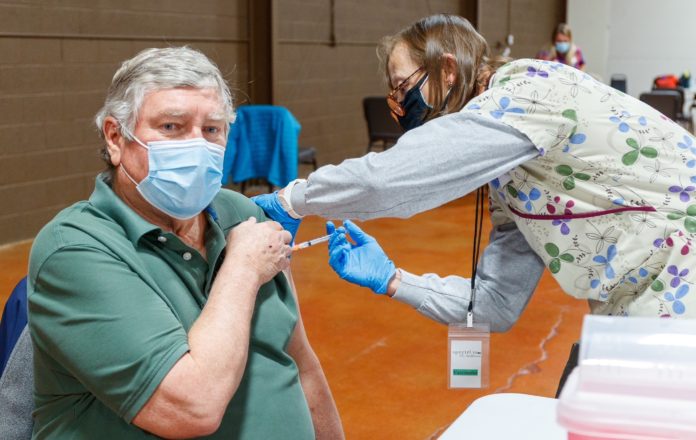Spectrum Healthcare opened up COVID-19 vaccination appointments to all individuals 65 and over on Jan. 19.
By Jan. 21, the online vaccine portal no longer accepted new appointments, as the health care nonprofit could no longer guarantee enough doses of the Moderna COVID-19 vaccine in Yavapai County to set up appointments past that.
In the weeks since, Spectrum has ramped up a large-scale vaccination machine, giving out over 15,000 vaccinations in the county, according to Vice President of Integration Sunshine Dean.
On the Prescott side of Yavapai County, Spectrum has moved into the Findlay Toyota Center, while in the Verde Valley it has taken over the large facility at Verde Valley Christian Church at 406 Sixth St. in Cottonwood to process large numbers of vaccinations quickly, bringing in volunteers, paid staff and employees of other agencies such as local fire departments and the Federal Emergency Management Agency to speed up operations.
Even as the distribution efforts are designed to get needles in arms quickly, lack of supply has continued to limit that speed.
“At our Cottonwood site, we could vaccinate 1,500 people a day,” Dean said. “At Prescott Toyota, we could vaccinate 2,000 to 2,500 per day. Obviously we’re vaccinating way below our capacity, and that’s because the amount of vaccine coming into our community is way down.”
Vaccine shortages only got worse in the past week, as a large shipment of Moderna doses got delayed reaching Arizona due to the extreme weather that has hit other parts of the country.
Spectrum announced on Tuesday that vaccination appointments on Wednesday and Thursday would be rescheduled, before on Wednesday closing all vaccination stations “until further notice.”
“We appreciate everyone’s patience and under- standing as we adjust our schedules to accommodate for a delayed shipment of this week’s allotment of the vaccine,” Spectrum CEO April Rhodes said. “All those who have a confirmed appointment are asked to check our website for details about when we can potentially see them for their immunization. Those who have a scheduled second dose appointment can still receive their injection up to two weeks after their scheduled appointment and have the same level of protection as stated on the Moderna vaccine information sheet.”
“Backlog of 6 [million] doses, impacting all 50 states. Road closures, snow days, power outages all factors,” U.S. Department of Health and Human Services spokesman Ian Sams tweeted on Friday morning. “We’re already working to clear backlog. 1.4 [million] doses in transit today, whole backlog delivered in the next week.”
Spectrum announced on Monday, Feb. 22, its intention to return to normal operations on Tuesday, Feb. 23, after the delays in supply.
Patients who had appointments delayed in the previous week are asked to return seven days after their initial appointment to get vaccinated.
Those who have managed to get the vaccine have been laudatory about Spectrum’s vaccination process, saying that when they actually go for their appointment, things have run smoothly, quickly and safely, with most people in and out in under half an hour, though those with potential allergies are asked to wait slightly longer in case of an adverse reaction. Most of the details, such as those potential allergies, are set up in advance as part of making the appointment, with the vaccination site designed to speed patients through with little fuss.
“I cannot think of a thing they could have done better. It’s like something done of the people by the people and for the people,” said Jeanne Freeland, a 70-year- old Sedona are resident who got her first dose in early February.
Freeland had faced some difficulty in signing up for an appointment, but said that once she showed up, everything was quick and easy. “It was like something done with military precision if the connotation of military was laid back and kind …. Everyone was so casual but really efficient. It was just a notably nice experience. You walked out feeling that the whole trajectory of your day was lightened.”
According to Spectrum staff, the key to this success was planning, having started setting up for vaccine distribution in the fall, before any vaccines had completed clinical trials.
“We started back in September,” said Matthew Timian, environment of care coordinator and safety officer at the Cottonwood location. “I started attending meetings and figuring out how to do this.”
“We were invited down to one of the very large [point of dispensing] sites at Honor Health [in Maricopa County]. That was Jan. 14,” Dean said. “It was really incredible how they operationalized everything there …. We took a lot of lessons away from the efficiencies they were doing there, but the biggest thing to us was that we have to look at this as an event, not as a health care visit. Health care visits have a lot of red tape involved with them. There’s a lot of administrative burden. When we changed our perspective on how to do as many vaccines as possible safely, we found there were a lot of things we were able to atomize to make that process go smoother.
“We did trial runs and a lot of things to make sure we were …. able to send people through quickly, because we didn’t want the 6 hour lines and wait times like we were hearing happen.”
In addition to the focus on speed, Spectrum is making efforts to ensure that no doses are wasted. The vials that contain the vaccine fluid usually have 10 shots worth in them, and once they are opened they expire within hours. Spectrum has set up a “waste list” of people who do not have formal appointments, but are called at the end of the day in case there are extra doses left over in opened vials. People are asked to come as soon as possible, in order to ensure that all the remaining doses end up in patients’ arms.
FEMA staff also praised Spectrum’s operations, saying that they were impressed by the nonprofit’s organization, as well as the community’s participation in the process.
FEMA staff are stationed at the vaccination centers as support, there to help out the health care staff in what- ever way necessary, which usually includes training volunteers, as well as filling in whatever roles need filled on a given day.
They are not taking a lead in operations, and when not needed, FEMA hangs back and lets Spectrum handle things.
“Spectrum is a well-oiled machine,” said crew leader Monica Curtis, who came to help away from Jacksonville, Fla. “It’s running smoothly. That’s what we hear from the residents as they’re leaving.”
“The community is so great,” Curtis added. “They’re always jumping in here.”
Northern Arizona Healthcare, which has begun a similar large- scale vaccination clinic in Flagstaff, has indicated that it hopes to open up its own vaccination stations in Sedona and Camp Verde, but has no formal plans as of press time.
According to NAH Chief Quality Officer John Mougin, the hospital system is vaccinating 500 people a day in Flagstaff, and hopes to be able to do the same at future Verde Valley locations, but would need to receive more doses of the vaccine in order to do so.
“We’re totally prepared at Sedona and Camp Verde that can do the same kind of numbers,” Mougin said. “We’ll match our operations with as much vaccine as they’re willing to send our way.”
While vaccinations stalled last week, the area continues to see a sharp decline in COVID cases after the surge in early January. The Verde Valley had just 103 new cases from Friday, Feb. 12, through Friday, Feb. 19, still high compared to much of the last year — at no point before the November surge started was it higher — but far below the peaks of nearly 600 a week in early January.
There are still fewer than 50,000 people in the county who have received at least one vaccine dose, and under 6,000 who have received two, meaning that the potential for COVID spread in the county of over 230,000 people remains high. Public health officials continue to recommend hand washing, maintaining a 6-foot distance from others and wearing a mask.



